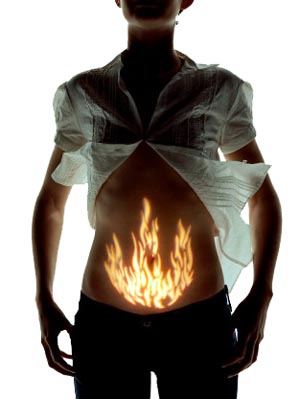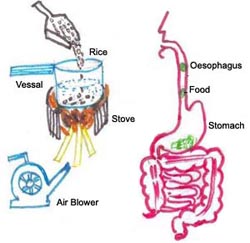Nov 05, 2025
Nov 05, 2025
 The word Indigestion is commonly used to describe the discomfort in one's belly mostly caused after food consumption. Fullness, bloating, nausea, heart burn are other symptoms of Indigestion.
The word Indigestion is commonly used to describe the discomfort in one's belly mostly caused after food consumption. Fullness, bloating, nausea, heart burn are other symptoms of Indigestion.
Before discussing Indigestion, understanding the process of digestion is very essential. The Ayurveda approach of explaining digestion is very simple and effective. The food we eat is digested by Agni or body fire which is present in our body. It is very much similar to the way we cook the food. The Agni or body fire helps to digest the food which is consumed, much like the fire of a stove cooks the food kept on it. The Agni is mainly situated in Jatara or in upper part of digestive system and is called as Jataragni. The Agni is further categorized as Bhootagni (which digests the 5 pancha mahabhoota factors present in food), Dhatwagni (The Agni present in tissues which help them to absorb required nutrients), Malagni ( the Agni which helps in formation of body wastes like stools, sweat and urine) . The Jataragni controls bhootagni, dhatwagni and malagni. Through this it is evident that ayurveda approach of digestion explains cellular metabolism too.
The factors which help Agni to digest the food completely: Thridoshas -Vata , Pitta and Kapha help Agni to digest the food.
 If the process of digestion is compared to that of cooking rice, the stomach, like the vessel., receives food. Vata provides the necessary conditions like the air blower, Pitta acts like the stove, providing optimum working conditions while Kapha provides the moisture needed much like the water in the vessel. When all these factors are normal and well balanced, an optimum condition is created to digest the food completely.
If the process of digestion is compared to that of cooking rice, the stomach, like the vessel., receives food. Vata provides the necessary conditions like the air blower, Pitta acts like the stove, providing optimum working conditions while Kapha provides the moisture needed much like the water in the vessel. When all these factors are normal and well balanced, an optimum condition is created to digest the food completely.
When food is completely digested by all the Agnis, the body tissues will be well nourished and one is blessed with attractive complexion, glow, longevity, strength, good health, growth, enthusiasm, vitality and overall healthy development of body and mind.
The indigestion occurs when Agni is imbalanced by the factors (tridoshas) which help Agni to digest food. The variations of Agni due to tridoshas are of 4 types.
Samagni (balanced Agni): The Agni which is well balanced due to balanced tridoshas indicate the condition called Samagni . Samagni digests the food completely and nourishes the body tissues very well.
Vishamaagni (varying Agni): When vata is predominant this condition surfaces. The regular food gets digested normally on some occasions and poorly on others. Vata increasing foods and lifestyles lead to this condition. This variation of Agni causes constipation, flatulence, pain in abdomen and other vata predominant diseases. The indigestion caused by this type of Agni is called Vistabdhajeerna
Teekshnagni (increased Agni): This variation of Agni occurs due to predominance of pitta. Pitta increasing foods and lifestyle cause this variation. This variation of Agni causes increased hunger, thirst, acidity, heart burn and loose motions. The indigestion thus caused is called as Vidagdajeerna.
Mandagni (decreased Agni): As increased moistness reduces the intensity of fire, the increased kapha reduces the intensity of Agni. Kapha increasing foods and lifestyle cause this variation. Feeling Heaviness of body, swelling of eyelids (lower), belching which emit the smell of food consumed and water brash are few symptoms which of indigestion caused by mandagni. The indigestion caused by mandagni is called as amajeerna.
The decreased Agni improperly digests the food and this indigested food is sticky in nature and improperly nourishes tissues, causing weakness of body. This sticky improperly digested food is called ama. Ama due to its sticky nature blocks the channels of body, vitiate doshas , contaminates tissues, imbalance body functions and cause diseases.
Causes of imbalance of Agni which lead to indigestion
Home Remedies for Indigestion
Disclaimer:
Information provided in this article is for the sole purpose of imparting education on Ayurveda and is not intended to diagnose, treat, cure or prevent any disease. If you have a medical condition, please consult your physician.
08-Apr-2007
More by : Dr. Savitha Suri